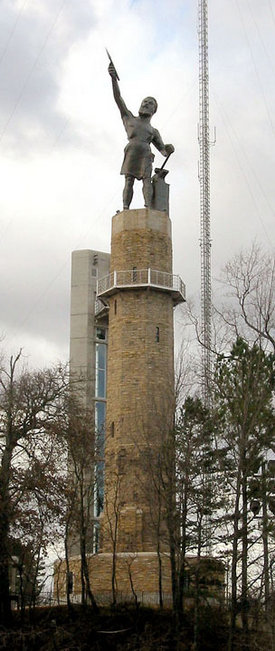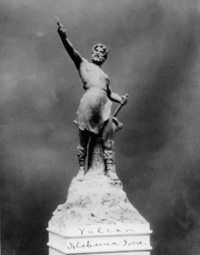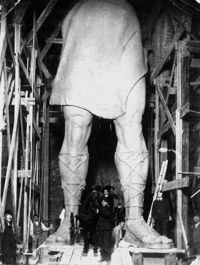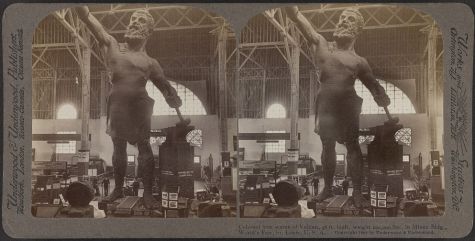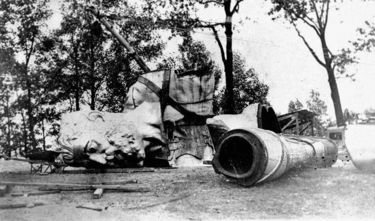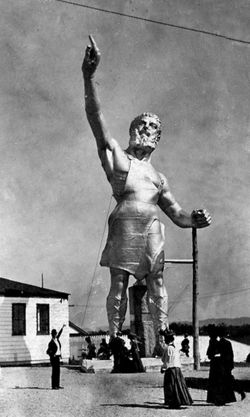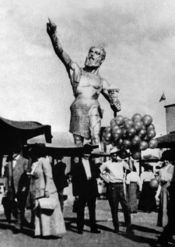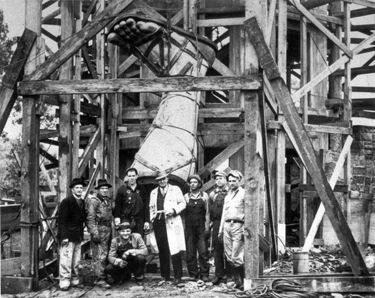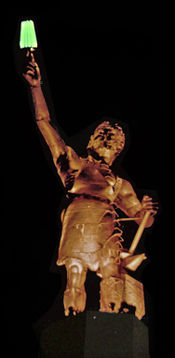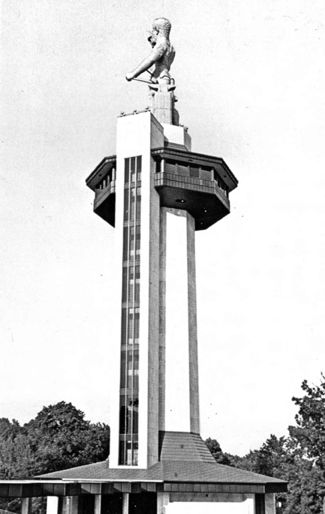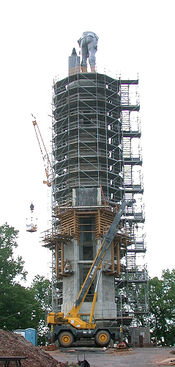Vulcan
- This article is about the Moretti statue. For other uses, see Vulcan (disambiguation).
Vulcan is the largest cast iron statue in the world and the best-known symbol of Birmingham. The 56 foot tall statue depicts Vulcan, the Roman god of the fire and forge. It was created to represent Birmingham's material resources 1904 World's Fair in St. Louis, Missouri. In 1939 it was installed as the centerpiece of Vulcan Park atop Red Mountain, near the road cut created for Montgomery Highway (map). The statue of Vulcan, along with the tower and the park grounds, underwent a significant program of restoration in 1999.
History
Conception
The Commercial Club of Birmingham met in May 1903 to discuss contributing materials demonstrating the Birmingham District's mineral resources to Alabama's exhibit at the Louisiana Purchase Exhibition the next summer in St Louis, Missouri. F. Y. Anderson suggested creating large relief maps that could be donated to schools at the conclusion of the fair.
In September, the club learned that the State of Alabama was not pursuing an official exhibit for the fair. W. G. P. Harding moved that the club raise $15,000 for their own submission to promote industrial development in Birmingham. Robert Jemison Jr seconded the motion, and the members voted in favor of the idea. James MacKnight, manager of the Alabama State Fairgrounds, proposed that instead of relief maps, the group could commission "a large figure made out of iron, steel, coal, limestone, and etc., to be about sixty feet tall," and further suggested that, "several thousand paper weights of the figure could be cast and sold to raise funds." In their October meeting the club voted to pursue MacKnight's idea, which had already been enthusiastically received by officials in St Louis, who promised to reserve an appropriate space in the Palace of Mines and Metallurgy.
A committee was formed to carry out the "giant man" project, including Fred Jackson, Rufus Rhodes, John Henry Adams, Joseph Beitman, Moses Joseph, Robert Jemison Jr, Culpepper Exum, William McQueen, Jones Moore, Thomas Bush, Frank Dixon, Ross Smith and Frank Nelson Jr. Rhodes devoted frequent editorials in his Birmingham News proclaiming the importance of the showing. The committee's efforts did not secure a pledge of financial support from Mayor Mel Drennen's administration, but did win a $5,000 pledge from the Jefferson County Board of Revenue and attracted dozens of new members to the Commercial Club.
It is not clear when the concept of a "giant man" evolved into a depiction of the Roman god, but the use of Classical figures as allegories was common in the period, especially in the context of public art. The association was already familiar in Birmingham in the crowning of "Rex Vulcan" during the Birmingham Carnival Society's Mardi-Gras celebrations of the 1890s.
Commission
In November 1903 MacKnight set out on a trip to "Boston and the East" to view monuments and interview sculptors. C. E. Dallin had expressed some interest in the project initially, but ultimately turned down the commission saying that "such a statue would require two to three years to make, and—anyone who thought it could be done in less time, was off the rails."
MacKnight next met with Italian-born sculptor Giuseppe Moretti, who was prepared to begin immediately. One of his earliest sketches was published alongside an article in The New York Herald before the end of the month. MacKnight reported that the sculptor was working on small figures to study the form and had already secured "a tall building at Edison's, at Jersey City" and a crew of ten men to execute the full-size plaster molds in time to cast the statue for the 1904 fair. The contract was signed, and announced in the Birmingham News on November 27.
Moretti completed an eight-foot clay model at his New York studio and brought it to the unfinished St Stephen's Roman Catholic Magyar Church in Passaic, New Jersey where he and his assistants recreated the figure in plaster at full-size. Then it was taken apart into sections and loaded onto train cars for shipping to Birmingham. The pieces were delivered to the former Hood Foundry at 1st Avenue North and 14th Street in downtown Birmingham, which James McWane had purchased for his newly-formed Birmingham Steel and Iron Company.
McWane assembled a team of fourteen foundrymen for the task of making moulds and casting the statue in iron. Charles Ledbetter was the superintendent of the plant and Barney Conlan the foreman of the team of foundrymen which included Fred Buettiker, Nick Smith, Charles Gustin, Jack Sorsby, Ike Swanson, Henry Veitch, Charles Zward, Dave Williams, Charles Cason, Clarence Hancock, Henry Stepp, George Rush and one other.
Moretti accompanied his artwork to Birmingham and supervised as the workmen designed and executed the connection details for the statue, which had no internal framework or skeleton. There is some indication that Vulcan's head suffered freeze damage before it was transported, and that Moretti made repairs to it while here. Any modification made to to the plaster models to accommodate the casting and assembly process also required the artist's approval. The castings were made using only locally-produced grey iron. The workers toiled, working 60-hour weeks for four months, to complete the statue in time. Despite the difficulty, all the castings were successful.
1904 Exposition
Vulcan was shipped to St. Louis in pieces in early spring 1904 with the final piece arriving on April 22, eight days before the exposition commenced. A contemporary account described the piecemeal giant strapped down to seven freight cars looking like Gulliver incapacitated by the Lilliputians. Without proper bolt holes cast to secure one of his arms, Vulcan stood at the fair incomplete through mid-May. He was finally dedicated on June 7, christened with water from the Cahaba River.
During the fair, both the phrases "Vulcan, god of fire and metals, cast at Birmingham, Alabama" and "Iron is king, its home, Birmingham, Ala." were painted in gold paint on the anvil. A dedicatory plaque included these lines, later dubbed "Vulcan's Prophecy" which were penned by John Henry Adams:
Just as my statue towers above the sons of earth, so shall the district from whose breast the ore and coal were torn and fused to give me birth, exceed all others in time's march. For o'er and o'er nature hath flung her treasures with a generous hand and Birmingham sits enthroned. Both hemispheres can draw on her; the mineral wealth of every land is there allied to rule the world in future years
Vulcan dramatically demonstrated the mineral and manufacturing riches of the Birmingham District at the Louisiana Purchase Exposition's Palace of Mines and Metallurgy, and was awarded the "Grand Prize".
Before the fair ended, the popularity of the statue resulted in other cities offering to purchase it and relocate it away from Birmingham. Some of these proposals were as follows:
- St. Louis wanted to purchase it and keep it in the city after the exposition
- San Francisco wanted to purchase it and set it up somewhere in San Francisco Bay as a "counterpart" to the Statue of Liberty
- Portland, Oregon reached an agreement to have Vulcan displayed atop a newly constructed pedestal for the 1905 Louis & Clark Exposition that later fell through due to lack of funding
- Another proposal called for Vulcan to be reconstructed in the middle of Chesapeake Bay
In February 1905, the statue was finally dismantled and returned to its hometown, only to be left in pieces alongside the railroad due to unpaid freight bills. One arm was badly damaged in the move, and Vulcan's spear point was lost.
Back in Birmingham
Vulcan remained in St Louis until February, 1905. The Commercial Club gratefully accepted an offer from the Louisville & Nashville Railroad to transport the statue back to Birmingham. They paid $450 to the Webber Drayage & Storage Company to dismantle the statue and bring it to the L&N siding in East St Louis, Illinois. The question of to where in Birmingham it should be delivered was harder to settle. Earlier publicity held that it would be displayed at Capitol Park, but residents of the mansions surrounding the newly-landscaped plot rallied against welcoming a colossal, bare-legged neighbor. Similarly Southside residents objected to a suggestion to place it in the center of Five Points Circle.
Engineer Llewellyn Johns offered to pay off the $3,000 of the club's remaining debt if they would place it at the intersection of 20th Street and the Railroad Reservation and dedicate it in honor of Henry F. DeBardeleben and arrange for it to be lit up at night. Robert Jemison Jr agreed to provide the lights if Johns would pay the electric bill. DeBardeleben himself declined to be have the "commercial" statue dedicated in his honor and suggested it be scrapped with the proceeds given to the newly-rebuilt Hillman Hospital. Others hoped that the iron giant would find a home on Red Mountain, but the sites suggested were too difficult to access.
Meanwhile, with the Birmingham Steel & Iron Co. having shuttered its foundry, the Club sought another firm to make repairs to the statue before it was due to be sent to Portland, Oregon on loan to the 1905 Lewis & Clark Centennial Exposition. The Beggs Pipe & Foundry Company at 3rd Avenue and 13th Street took Vulcan's damaged right arm and used it to create a mould for a replacement casting. The rest of the statue remained for several weeks on L & N's cars sitting just west of 18th Street between Morris Avenue and 1st Avenue North. When the railroad's patience was exhausted, they hauled the load up to an unused siding on Red Mountain and unceremoniously dumped him into the grass and weeds. The Club's remaining debts made it impossible to prepare the statue for transport to Oregon and the promised loan to Fair organizers there was withdrawn. The tragedy of the Virginia City Mine explosion on February 20 in which 112 people were killed turned the city's attention away from Vulcan, and he was left where he sat for another twenty months. The Birmingham Board of Aldermen voted 11-4 on the evening March 21, 1906 to proceed with the Commecial Club's plans to display the statue in Capitol Park. The club did not, in fact, proceed with those plans.
At the fairgrounds
In the Summer of 1906 J. H. Emery approached Alabama State Fairgrounds president Culpepper Exum about assembling Vulcan at the 1906 Alabama State Fair. Exum agreed if Emery could find the funds to transport and assemble him. It was considered a temporary reprieve for the broken giant until he could find a more suitable home. To transport the statue from the L & N siding to the Fair Grounds required him to be carried all the way to Bessemer, where the cars could be switched onto streetcar tracks near the Robertstown Furnaces, then pulled back to the Fairground on the Birmingham & Bessemer Dummy Line. The streetcar company announced that since Vulcan was only two years old, he qualified to ride for free on their line. He arrived at the fairgrounds on Sunday October 13 and was hastily assembled for his debut that Wednseday. Workers accidentally attached the figure's right arm incorrectly, making Vulcan look as if he were pointing at the sky. The angle made it impossible to secure the newly recreated spearpoint, so it was left at his feet.
Augusta Jenkins hit on the idea of using Vulcan's empty left hand to hold an oversized plaster ice cream cone from her Weldon-Jenkins Ice Cream stand. After 1914 the fair authority leased the empty hand to various advertisers. During his time at the fairgrounds he advertised Shewin-Williams paints, Heinz pickles, and Coca-Cola. As a highly recognizable landmark at the fairgrounds, Vulcan served the important purpose of reuniting lost children with their parents. A generation of kids learned to "meet me at the foot of Vulcan."
According to a popular legend, Vulcan's right thumb fell off and injured a bystander. A swarm of honeybees later occupied the opening in the hand. In 1929 the Birmingham Welding Company fabricated and installed a new copper thumb. In the early 1930s the entire statue was disassembled for inspection. He resumed his familiar pose afterward, but was painted in "flesh" color with black hair and eyebrows, a touch of "rouge" on his cheeks, and blue apron. A nearby sign attempted to convince fairgoers that the backless apron was Vulcan's version of "long-lasting Liberty overalls".
The sequence of embarrassments for the once-proud God of Iron did not escape the notice of his sculptor. Before his death in 1935, Moretti was quoted as saying "I almost wish I had never made him" in response to the ignoble way his statue was being displayed and handled at the fairgrounds.
On Red Mountain
When Birmingham Kiwanis Club charter member Tom Joy returned to Birmingham after selling his successful Chicago construction business, he found his former civic league had deteriorated into "nothing but a backslapping, song-singing, weekly-lunching bunch." He challenged the Kiwanians to create and execute a plan to find a new home for the Vulcan statue.
In early 1929 he and Mercer Barnett began a campaign to place Vulcan on a more suitable pedestal. Delayed by the stock market crash, they resumed their efforts in 1934 as co-chairs of a committee organized jointly by the Kiwanis, the Birmingham City Commission and the Birmingham Park and Recreation Board. They communicated with Thad Holt, Alabama state director for the Works Progress Administration, about the possibility of qualifying for a government grant for the project.
At Holt's request, the Kiwanians were able to drum up popular support for the move. The Tennessee Coal, Iron and Railroad Company donated five acres of former mining land near the Birmingham Mineral Railroad on Red Mountain. Crews began the process of dismantling the Vulcan statue in the summer of 1936. The first crew was ill-prepared for the weight of the iron castings and succeeded in damaging their scaffolding by dropping Vulcan's ill-starred right arm. A new crew from the Ironworkers Local 92 was brought in to finish the job.
After evaluating proposed designs from various architects, including one by Warren Knight and Davis, a park plan was drawn up by Robert Marshall, superintendent of the Birmingham Parks & Recreation Department. A 124-foot pedestal was built with a reinforced concrete frame, filled in with local sandstone. Vulcan, sporting a new coat of bright aluminum paint, was hoisted onto a thick concrete cap on top beginning on November 4. A new spear, smaller than the original, was fabricated to be held aloft in his right hand. The anvil was moved closer to statue's feet to fit better on the narrow tower, requiring a modification to the way Vulcan held his hammer in this right hand.
Leading down the hill from the south side of the tower were two flights of stone steps, divided by a "cascade" of terraced pools planted with lilies. Plans for neon lighting to illuminate his spear and hammer were shelved. The cost of the three-year project was calculated at $44,062, of which $38,874 was contributed from federal funds.
A ten day "Vulcan Dedication Celebration" commenced on May 7, 1939 to dedicate Vulcan Park. Miss Evelyn Tully was crowned "Miss Vulcan" by committee president Erskine Ramsey. Guests of honor included the original foundrymen who cast Vulcan. A crowd of 5,000 was present for the opening night of the festival.
The statue and tower are exposed to harsh weather conditions atop Red Mountain and both require frequent inspection, maintenance and repairs. In 1955 parks superintendent King Sparks awarded a contract to Holmes Company of Trussville to repair mortar on the tower and repaint the statue. Members of the Paper Hangers and Decorators Local No. 57 picketed the site to protest the no-bid contract. Sparks defended the department by stating that the engineer had recommended the company for its dual expertise as painters and steeplejacks.
Road safety beacon
To take full advantage of Vulcan's position overlooking Birmingham, the city's Junior Chamber of Commerce in 1946 made the statue into a symbol for road safety. His spear was replaced by a neon torch that glowed green, except during the 24 hours following a fatal traffic accident, when it glowed red.
The traffic safety light was first lit at a dedication ceremony on October 23, 1946 and remained green for ten days, first signaling a fatality on November 1 of that year. For the week of February 17–24, 1963 the torch was turned red for heart disease deaths rather than traffic fatalities as a show of support for the Heart Fund Drive.
In 1949, Vulcan found some new neighbors, when two television stations, WAFM-TV (now WVTM) and WBRC 6 located their studios and towers in "Radio Park" adjoining Vulcan Park on Red Mountain.
A "tree of lights" was erected at Vulcan during the Christmas season in the 1960s. In 1964 the lights were made to glow red for each "suspicious chest x-ray," indicative of possible childhood tuberculosis, which was discovered by the Christmas Seal X-Raymobile or the Chest X-Ray Center at 900 18th Street South.
1959 repairs
For a month in 1959 the statue's pedestal was closed to climbers as a repair project was completed. Though an engineer's report on the condition of the structure was generally favorable, the Park & Recreation Board was determined not to leave even a 1 in 1000 chance that anyone would be injured while visiting the monument. Architect Arnold Largin drew up plans for new steel supports for the observation platform and repairs to the stairway inside the tower. The cost of the repairs was estimated at about $8,500.
Centennial facelift
In 1967 the Park Board found that repairs were needed to maintain the condition of the statue. Those repairs were included in a proposal for a major facelift for Vulcan Park. Voters approved the sale of $1 million in city-backed bonds to fund the project and architect Marion Bradford of Elliot & Bradford proceeded to design a modern-styled, more accessible attraction.
Beginning in 1968, the original sandstone tower was given a new outer cladding of Alabama marble with a new elevator and enclosed observation deck added. A covered walkway also connected a gift shop and snack bar. The park was rededicated on April 8, 1972.
Vulcan was repainted a with a rust red primer a few years later, reflecting "the iron ore he is made of." Public comments received by the city strongly preferred a return to the earlier silver-gray color, but the board unanimously supported Tom Bradford's motion to keep the red, which was renewed approximately every two years.
Vulcan was listed on the National Register of Historic Places on July 6, 1976.
Unfortunately, the statue itself had, at some point, been filled up to the chest with concrete and had begun to deteriorate seriously. By 1990, an engineering study found that the statue was in danger of collapse.
1999-2004 restoration
Vulcan was removed during October and November of 1999 in preparations for a $14 million renovation process that saw the park and pedestal restored to its original 1938 appearance. The statue sat in Vulcan Park's parking lot until the fall of 2001, when it was shipped to Robinson Iron in Alexander City to be repaired. The statue itself was thoroughly inspected and repaired, with some parts, including the lost spear point, re-cast. The new and restored pieces were coated with a thick, durable finish, topped with a light gray, dubbed "Vulcan gray" by the paint consultant who supplied the specification.
Meanwhile in 2002, the 1971 additions to the park were demolished, and scaffolding went up around Vulcan's tower. Brice Building Company served as general contractor with crews from Masonry Arts doing the masonry work to clean and repair the original tower. Vulcan's head and right arm went on display at the Birmingham Museum of Art while the tower was prepared.
Vulcan was re-erected on a steel armature atop his tower during June 2003, restored to its original appearance as intended by Moretti, and slightly reoriented to the east to better accommodate the original position of his anvil. WVTM and WBRC both provided live webcams of the installation process.
Shortly after the statue was reinstalled, the scaffolding came down, and a new observation deck providing panoramic views of downtown Birmingham, Red Mountain, and Homewood was installed. The original museum space surrounding the base was rebuilt, though it now serves as a storage area. A new elevator was installed, oriented so it would not be easily seen from downtown Birmingham. The original waterfalls were not rebuilt, though the stone walkways leading from the parking lot directly to Vulcan's tower were restored.
In 2006 the restoration was given an Honor Award by the National Trust for Historic Preservation. $1.5 million of the restoration cost was included in the 2001 Interior Department Appropriations Bill (passed in 2000) at the request of Senator Richard Shelby. The use of federal funds for the project was criticized by Senator John McCain of Arizona who introduced an amendment to block the measure. The full Senate overrode the block by a vote of 87-12. McCain continued to use the measure as an example of egregious "pork" spending during his 2008 presidential campaign.
Later work
The observation deck was closed from June 2023 to February 2024 to allow for a full cleaning and re-sealing of the exterior of the sandstone tower.
Vulcan Park
Vulcan Park is the 10-acre urban green space surrounding the statue. A new visitor's center, called the Vulcan Center, features interactive exhibits and displays that give insight into the region's history and the industrial growth of the Birmingham District. It also tells Vulcan's story and has a full-size replica of Vulcan's foot, that was cast in fiberglass in 1991, giving visitors a better sense of the statue's size.
The Vulcan statue has been repainted twice since being returned to its pedestal; once in 2010 and again in 2017.
In January 2008 Vulcan Park and Museum unveiled a gray plush-suited Vulcan mascot to promote park activities and tourism and to assist with educational outreach.
Trivia
- In June 1926, The Birmingham Post ran a daily column by "Dr. B. U. L. Conner" describing a mythical love affair between Vulcan and the statue of Electra atop the 1925 Alabama Power Building.
- From the 1940s to the 1970s (at least), The Birmingham News ran a regular column called "From Where I Stand". Although written by various staff members, it was always signed as being by "Ol' Vulc".
- In March 1955 an article by "Bonanza Bill" in the News told of a Blount Countian going by the name "Al" who divulged plans to move Vulcan to Hemingway Hill near Bangor while dropping off his "Cashword" entries at the newspaper office. He showed a woman in the want-ad department the first few names on a petition, including Lorenzo Dow, Fanny Burney and Ambrose Bierce.
- The statue's naked buttocks are a well-known source of humor, inspiring Jack Voorhies' 1982 novelty song, "Moon Over Homewood."
- Birmingham's World Football League team, the Birmingham Vulcans were named for the statue.
- President George W. Bush's foreign policy advisory team, led by Condoleezza Rice was nicknamed "The Vulcans".
- The student-run historical journal at UAB is the Vulcan Historical Review.
- The statue was featured prominently on the 2022 World Games medals.
- See also List of companies named after Vulcan.
References
- "Vulcan To Stand In Capitol Park" (March 22, 1906) The Birmingham News, p. 11
- "Welding Job on Vulcan Handled by the Birmingham Welding Co." (September 29, 1929) The Dixie Manufacturer. Vol. 21, No. 6, p. 7
- "Art: Iron Man" (August 17, 1936) TIME magazine
- "Two credited with Vulcan renaissance" (c. 1939) clipping in the Birmingham Public Library archives - accessed May 21, 2008
- "City defends contract—Painters picket Vulcan, halt job" (November 1955) The Birmingham News - via Birmingham Rewound
- "Vulcan to take vacation" (June 1959) The Birmingham News
- Rowell, Raymond J. Sr (1972) Vulcan in Birmingham. Birmingham: Birmingham Park & Recreation Board
- "Vulcan to stay red despite public's negative response" (July 15, 1976) Birmingham Post-Herald - via Birmingham Public Library Digital Collections
- Thompson, George Clinton (Spring 1991) "Vulcan: Birmingham's Man of Iron" Alabama Heritage No. 20
- "Vulcan statue." Wikipedia, The Free Encyclopedia. 20 Mar 2006, 00:29 UTC. 20 Mar 2006, 00:31 [1].
- Morris, Philip A. (1995) Vulcan and His Times. Birmingham: Birmingham Historical Society.
- Bragg, Rick (March 22, 1997) "In Birmingham, a Big Iron Man Gets No Respect" The New York Times
- Howell, J. Scott (2004) "Bringing Back the Magic: Restoring Giuseppe Moretti's Vulcan in Birmingham, Alabama." APT Bulletin: The Journal of Preservation Technology. Volume XXXV, No. 2-3. ISSN 00449466
- Library of Congress page about the Vulcan statue, accessed November 7, 2006.
- Firestone, David (July 9, 2001) "Ailing Statue: Symbol of Industry or Pork Barrel?" The New York Times
- Knight, Shirley Bridges (2002) "The Man Who Hand-Curled Vulcan's Beard" in The Heritage of Jefferson County, Alabama (2002) Clanton: Heritage Publishing Consultants. ISBN 1891647547
- Davis, Rachel (June 17, 2003) "Iron man makes partial return" Kaleidoscope. Vol. 37, No. 21, p. 1
- Dean, Charles J. (April 24, 2008) "GOP candidate McCain OK with funding for Gee's Bend ferry, assails that for Vulcan." The Birmingham News
- "The Vulcans" Wikipedia
- Garrison, Greg (February 2, 2024) "One of Birmingham’s top tourist attractions could soon reopen." AL.com
External links
- Vulcan Park Foundation
- Vulcan archives at the Birmingham Public Library
- Vulcan restoration project site at Robinson Iron
- Gallery of Vulcan photos at Flickr.com
- 3-D model of Vulcan statue and pedestal by Jordan Herring
